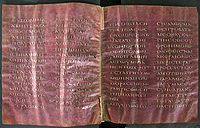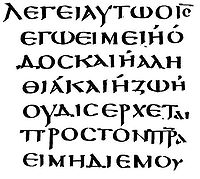
Codex Petropolitanus Purpureus
| New Testament manuscript | |
 Matthew 10:10-17 | |
| Name | Petropolitanus Purpureus |
|---|---|
| Sign | N |
| Text | Gospels |
| Date | 6th century |
| Script | Greek |
| Found | Sarmisahly (or Sarumsahly) |
| Now at | National Library of Russia |
| Size | 32 cm x 27 cm |
| Type | Byzantine |
| Category | V |
| Note | purple codex |
The Codex Petropolitanus Purpureus ("Purple Codex of Saint Petersburg"), designated by N or 022 (in the Gregory-Aland numbering of New Testament manuscripts), ε19 (in the von Soden numbering of New Testament manuscripts), is a Greek New Testament codex containing the four Gospels written on parchment. Using the study of comparative writing styles (palaeography), it has been assigned to the 6th century CE.[1]

Codex Petropolitanus Purpureus, along with the manuscripts Codex Beratinus (Φ), Sinope Gospels (O), and Rossano Gospels (Σ), belongs to the group of the Purple Uncials. The manuscript has many gaps.[1]

Description
The manuscript is a codex (precursor to the modern book), containing the text of the four Gospels on 231 parchment leaves (32 x 27 cm), with the text written in two columns, 16 lines per page, 12 letters in line, in large uncial letters. The lettering is in silver ink on vellum that has been dyed purple, with gold ink used for the nomina sacra (these being words and names considered sacred in Christian writings: ΙΣ for Jesus, ΘΣ for God, ΚΣ for Lord or Master, ΥΣ for Son, and ΣΩΤΗΡ for saviour). It has errors of iotacisms (misspelling of similar sounding letters and combinations of letters), such as the change of ι with ει, and αι with ε (and vice-versa).[2] It has been calculated the original codex contained 462 leaves.[3]

The tables of contents (known as κεφάλαια / kephalaia) are placed before each Gospel. The text is divided according to the chapters (also known as κεφάλαια), whose numbers are given at the margin, with the titles of the chapters (known as τίτλοι / titloi) written at the top of the pages. The Ammonian sections and the Eusebian Canons are presented in the margin.[2]

Missing portions
Gospel of Matthew 1:1-24, 2:7-20, 3:4-6:24, 7:15-8:1, 8:24-31, 10:28-11:3, 12:40-13:4, 13:33-41, 14:6-22, 15:14-31, 16:7-18:5, 18:26-19:6, 19:13-20:6, 21:19-26:57, 26:65-27:26, 27:34-end;

Gospel of Mark 1:1-5:20. 7:4-20, 8:32-9:1, 10:43-11:7, 12:19-14:25, 15:23-33, 15:42-16:20;

Gospel of Luke 1:1-2:23, 4:3-19, 4:26-35, 4:42-5:12, 5:33-9:7, 9:21-28, 9:36-58, 10:4-12, 10:35-11:14, 11:23-12:12, 12:21-29, 18:32-19:17, 20:30-21:22, 22:49-57, 23:41-24:13, 24:21-39, 24:49-end;

Gospel of John 1:1-21, 1:39-2:6, 3:30-4:5, 5:3-10, 5:19-26, 6:49-57, 9:33-14:2, 14:11-15:14, 15:22-16:15, 20:23-25, 20:28-30, 21:20-end.[4]: 691

Text
The text of the codex is considered to be a representative of the Byzantine text-type, with numerous pre-Byzantine readings.[5]: 79 According to 19th century biblical scholar Frederick H. A. Scrivener, "it exhibits strong Alexandrian forms."[6] According to biblical scholar Burnett Hillman Streeter, in parts it has some Caesarean readings. Biblical scholar Kurt Aland placed it in Category V of his New Testament manuscripts classification system,[1] and it is certain that it is more Byzantine than anything else.

The texts of Luke 22:43-44, and John 7:53–8:11 are omitted.

In John 1:27 it has the addition εκεινος υμας Βαπτιζει εν πνευματι αγιω και πυρι (He shall baptise you with the Holy Spirit and fire).[4]: 249

History

It is understood that the manuscript originated in the imperial scriptorium of Constantinople and was dismembered by crusaders in the 12th century. In 1896 Nicholas II of Russia commissioned Fyodor Uspensky's Russian Archaeological Institute of Constantinople to buy the greater part of it for the Imperial Public Library in St. Petersburg.[2]

The codex was examined by scholar Peter Lambeck, Bernard de Montfaucon, Hermann Treschow, Francis Alter, Hartel, Wickholf, Giuseppe Bianchini, Harry S. Cronin,[7] and Louis Duchesne.

Textual critic Johann Jakob Wettstein examined 4 leaves housed at London (Cotton Titus C. XV) in 1715, and marked them by I.[8]: 40 Wettstein cited only 5 of its readings. According to Scrivener it has 57 variant readings.[9][6]: 139–140 Bianchini described portions housed at the Vatican Library. The same portions were examined and collated for textual critic Johann M. Augustin Scholz by Gaetano Luigi Marini.

The Vienna fragments of Codex Vindobonensis were examined by Wettstein, who marked them by the siglum N.[8]: 41 Treschow in 1773 and Alter in 1787 had given imperfect collations of the Vienna fragments.[10] Lambeck gave the wrong suggestion that the Vienna fragments and the Vienna Genesis manuscript originally belonged to the same codex.[2][11]

Textual critic Constantin von Tischendorf published fragments of this manuscript in 1846 in his Monumenta sacra et profana. Tischendorf considered it as a fragment of the same codex as 6 leaves from the Vatican, and 2 leaves from Vienna.[9]

Louis Duchesne described the Patmos portions (1876).[12] The Athens and New York portions were edited by Stanley Rypins in 1956.

A facsimile of all the manuscript's fragments was published in 2002 in Athens.[13]

Biblical scholar Elijah Hixson published a monograph in 2019 entitled, Scribal Habits in Sixth-Century Greek Purple Codices.[14] In it, Hixson has a transcription for all of the extant portions of Matthew. The monograph was highly praised by Thomas Kraus,[15] Hixson's own summary of his dissertation (which was the basis for the monograph),[16] and his interview with James Snapp on the purple codices.[17]

Present location

The 231 extant leaves (known as folios) of the manuscript are kept in different libraries:[18]

- 182 leaves are in the National Library of Russia in Saint Petersburg,
- 33 leaves are in the Library[19] of the Monastery of Saint John the Theologian on the Island of Patmos, Greece, Mark 6:53-7:4; 7:20-8:32; 9:1-10:43; 11:7-12:19; 14:25-15:23;
- 6 leaves are in the Vatican Library in Vatican, Matthew 19:6-13; 20:6-22; 20:29-21:19
- 4 leaves are in London, British Library, Cotton Titus C. XV; Matthew 26:57-65; 27:26-34; John 14:2-10; 15:15-22; they were named the Codex Cottonianus;
- 2 leaves are in the National Library of Austria in Vienna,
- 1 leaf is in the Morgan Library in New York,
- 1 leaf is in the Byzantine Museum in Athens,
- 1 leaf is in the Museum of Byzantine Culture in Thessaloniki
- 1 leaf is in the private collection of Marquis А. Spinola in Lerma (1), Italy.
See also
References
- ^ a b c Aland, Kurt; Aland, Barbara (1995). The Text of the New Testament: An Introduction to the Critical Editions and to the Theory and Practice of Modern Textual Criticism. Erroll F. Rhodes (trans.). Grand Rapids: William B. Eerdmans Publishing Company. p. 113. ISBN 978-0-8028-4098-1.
- ^ a b c d Gregory, Caspar René (1900). Textkritik des Neuen Testaments. Vol. 1. Leipzig: J.C. Hinrichs. pp. 56–58.
- ^ Kenyon, Frederic G. (1910). Handbook to the Textual Criticism of the New Testament. London: Macmillan & Co. p. 110.
- ^ a b Aland, Kurt; Black, Matthew; Martini, Carlo Maria; Metzger, Bruce M.; Wikgren, Allen, eds. (1981). Nestle-Aland Novum Testamentum Graece (26 ed.). Stuttgart: Deutsche Bibelstiftung. ISBN 3-438-051001. (NA26)
- ^ Metzger, Bruce Manning; Ehrman, Bart D. (2005). The Text of the New Testament: Its Transmission, Corruption and Restoration (4th ed.). Oxford: Oxford University Press. p. 141. ISBN 0-19-516667-1.
- ^ a b Scrivener, Frederick Henry Ambrose; Edward Miller (1894). A Plain Introduction to the Criticism of the New Testament. Vol. 1 (4 ed.). London: George Bell & Sons.
- ^ Cronin, Harry Stovell (1899). Codex Purpureus Petropolitanus: The text of Codex N of the Gospels edited with an Introduction and an Appendix. Cambridge: C. J. Clay and Sons.
- ^ a b Wettstein, Johann Jakob (1751). Novum Testamentum Graecum editionis receptae cum lectionibus variantibus codicum manuscripts (in Latin). Vol. 1. Amsterdam: Ex Officina Dommeriana. Retrieved November 14, 2010.
- ^ a b Scrivener, Frederick Henry Ambrose (1852). A Full and Exact Collation of About 20 Greek Manuscripts of the Holy Gospels. Cambridge; London: Cambridge University Press. p. XL. ISBN 978-1-108-00747-4.
- ^ F. K. Alter, Novum Testamentum Graecum, ad Codicem Vindobonensem Graece expressum: Varietam Lectionis addidit Franciscus Carolus Alter, 1 vol., Vienna, 999-1001.
- ^ P. Lambeck, Commentarii De Augustissima Bibliotheca Caesarea Vindobonensi ed. alt. opera et studio Adami Franc. Kollarii, Wien, Bd. (Buch) 3 (1776), col. 30-32.
- ^ Duchesne, Louis (1876). "Fragments de L'Evangile selon Saint Marc". Archives des missions scientifiques et littéraires (in French). 3 (1). Paris: National Printing Office: 386–419.
- ^ The purple codex of the Gospels of Patmos and Petroupolis, Athens 2002.
- ^ Hixson, Elijah. "Scribal Habits in Sixth-Century Greek Purple Codices". Leiden: Brill. ISBN 978-90-04-39990-7.
- ^ Kraus, Thomas. "Review of Elijah Hixson, Scribal Habits in Sixth-Century Greek Purple Codices" (PDF). TC: A Journal of Biblical Textual Criticism.
- ^ Hixson, Elijah. "The Gospel of Matthew in a Sixth-century Manuscript Family" (PDF). Tyndale Bulletin.
- ^ Snapp Jr., James; Hixson, Elijah. "Elijah Hixson and the Purple Uncials". The Text of the Gospels.
- ^ "Liste Handschriften". Münster: Institute for New Testament Textual Research. Retrieved 16 March 2013.
- ^ Presently it is exposed in the museum of the monastery
Further reading
- Constantin von Tischendorf, „Monumenta sacra inedita“, Leipzig, 1846, pp. 15–24.
- S. P. Tregelles, "An Introduction to the Critical study and Knowledge of the Holy Scriptures", London 1856, pp. 177–178.
- S. Rypins, Two Inedited Leaves of Codex N, JBL Vol. 75, No. 1 (Mar. 1956), pp. 27–39.
- Kurt Weitzmann, ed., Age of spirituality : late antique and early Christian art, third to seventh century, no. 444, 1979, Metropolitan Museum of Art, New York, ISBN 9780870991790; full text available online from The Metropolitan Museum of Art Libraries
External links
- Codex Petropolitanus Purpureus N (022) at the Encyclopedia of Textual Criticism
- Codex Petropolitanus Purpureus at the National Library of Russia, 2007
See what we do next...
OR
By submitting your email or phone number, you're giving mschf permission to send you email and/or recurring marketing texts. Data rates may apply. Text stop to cancel, help for help.
Success: You're subscribed now !
